
The design of the Penny Universal was changed in 1909 in recognition that New Zealand was now a Dominion.

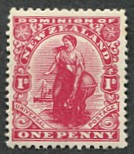 Two plates of 240 stamps were produced by Perkins Bacon
and stamps were issued on 18 November 1909.
They were on De la Rue chalk surfaced paper with watermark
NZ and star and perforation 14x15.
Two plates of 240 stamps were produced by Perkins Bacon
and stamps were issued on 18 November 1909.
They were on De la Rue chalk surfaced paper with watermark
NZ and star and perforation 14x15.
Stamps overprinted Official were issued in December 1909.
After 1924, there were issues on several different papers.
- June 1924: Jones chalk surfaced paper; also issued overprinted Official in 1925,
- April 1925: small numbers on unsurfaced De La Rue paper and surfaced paper with sideways watermark,
- July 1925: unwatermarked paper in which a lithographed ''watermark'' was printed; also issued overprinted Official in 1925,
- August 1925: Cowan thick chalky paper; also issued overprinted Official in 1925,
- 1926: Cowan thick chalky paper surfaced on the wrong side and so the stamps were issued with reversed watermark; also issued overprinted Official in 1926,
- June 1926: dull carmine on Wiggins Teape paper with vertical mesh. Stamps from the top row were blurred.
The stamps were replaced by the King George V Field Marshall in November 1926.
There were two plates which are recorded as 12 and 13 although
the numbers did not appear on the plate.
Plate 12 was used throughout the issue while plate 13 only
occurs on stamps on De La Rue paper.
Flaws


Plate 12
There are constant flaws on both plates. On plate 12, the feather (R3/1) and globe (R5/24) flaws are best known while another prominent flaw is the missing part of the top frame line (R6/21). They exist on all papers.
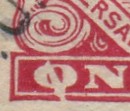

Plate 13
On plate 13, the Q flaw (R10/19) and the split in the ship's bow (R9/19) are best known.
They only exist on stamps on De La Rue paper.
Booklet plates
The first penny Dominion booklet stamps were printed from electrotype plates and were issued in 1910 in booklets along with the Edward VII halfpenny. This was replaced in 1915 by the George V halfpenny.
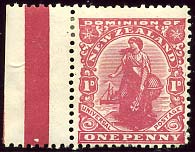
The appearance of the booklet stamps was less clear than the normal stamps and the plates did not wear well leading to blurred prints as shown in the image. This was solved in 1919 when a steel booklet plate was produced by Perkins Bacon.
The stamps were on De La Rue paper until 1924 when they appeared on Jones paper. After 1925, adverts were printed in the selvedge of the booklet panes. The binding selvedge had Jeyes Fluid adverts while the side selvedges had Abdulla, Dainties, Big Tree and Kaitangata Coal adverts. There were nine different Abdulla cigarette adverts.
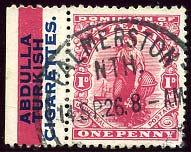
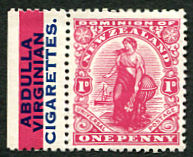
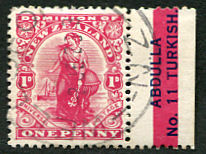

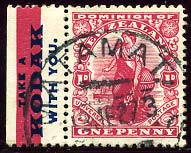
Booklets with Kodak adverts, all on Cowan paper with reversed watermark, appeared in 1927.
The above information is taken from The Postage Stamps of New Zealand Vol 1, published by the Royal Philatelic Society of New Zealand in 1938 and Vol 4 in 1964. All scans were made by the author.